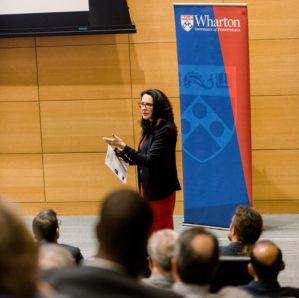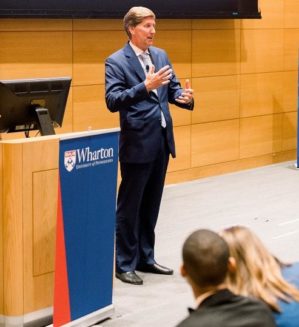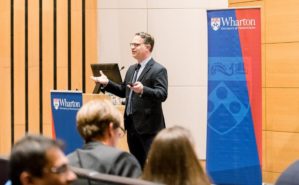Wharton Leadership Conference 2018: “Leading in a World of Seismic Shifts”
 At the 22nd Annual Wharton Leadership Conference, extraordinary leaders from the food industry, the Department of Defense, polar tourism, the nonprofit world, health care, journalism, the National Park Service, management consulting, and banking told how they are taking their organizations boldly into the future.
At the 22nd Annual Wharton Leadership Conference, extraordinary leaders from the food industry, the Department of Defense, polar tourism, the nonprofit world, health care, journalism, the National Park Service, management consulting, and banking told how they are taking their organizations boldly into the future.
Although coming from such different walks of life, the speakers agreed that business was undergoing cataclysmic disruption. From digital, robotics, and artificial intelligence to social media, crowdsourcing, and new market entrants, leaders are being buffeted from all sides by novel ideas and technologies, and the exponentially increasing pace of change.
As if that weren’t enough, there is so much riding on today’s business executives, said co-host Wharton management professor Peter Cappelli. “I can’t think of another moment in time when we as a country were as dependent on the leaders of the kind of organizations we’re going to hear from today. Leaders from the corporate world, the civic world, various social institutions, picking up the lead for the country.”
Co-host Wharton management professor Mike Useem asked the participants, as they went through the day, to think about how their own business environments have become more seismic. Moreover, what was the best path to ready their own leadership for “a future that is going to be more unpredictable and disruptible?”
Kat Cole of FOCUS Brands: A Journey from Hooters Waitress to Top Executive
Kat Cole’s rise to the top of a major American company was anything but typical. The child of a struggling divorced mother, she became a Hooters waitress while in high school. She emerged as a star employee and was invited to help open new franchises in other countries. By age 26, she was a Hooters executive vice president, and only a few years later became president of Cinnabon.

Today, at age 40, she is Group President of the billion-dollar FOCUS Brands, which includes Cinnabon, Auntie Anne’s, Moe’s Southwest Grill, and Schlotzsky’s.
In Cole’s world, leadership means “leading through influence” because of the franchise model she works in. While executives in other fields may have only a handful of business partners, she said, she has “1,200 to 1,500 people that I need to get to agree, in order to get almost anything done in the organization.” And some franchisees may have their entire life savings invested in their store, so they’re understandably hesitant about new initiatives. Cole focuses on the “coalition of the willing” who see the bigger picture and move forward. Once they demonstrate that there’s a sales lift, others will follow suit.
Cole noted that while the food business might seem simple and non-digital, it really isn’t. “The consumer is high-tech; the supply chain and infrastructure are enabled by technology.” New entrants into the market, too, quickly take advantage of technology, which means that established players must be knowledgeable and vigilant.
The leadership lessons she’s learned said Cole, “have informed a pretty non-traditional professional path.” Yet Cole and FOCUS Brands are tackling the same phenomenon faced by many at the conference and across the business world: “a high degree of continual and rapid disruption.”
Henry Timms of 92nd Street Y and Jeremy Heimans of Purpose: How Leaders Can Harness “New Power”
The #MeToo movement takes off and gains steam… A Scottish teenager runs away to Syria and becomes an online ISIS recruiter of young girls… In California, Airbnb mobilizes guests and the  community to defeat regulatory legislation… What do these seemingly disparate, recent events have in common? asked Henry Timms and Jeremy Heimans. The answer: they’re all examples of New Power.
community to defeat regulatory legislation… What do these seemingly disparate, recent events have in common? asked Henry Timms and Jeremy Heimans. The answer: they’re all examples of New Power.
“New Power is an essential skill, which is to harness the energy of the connected crowd,” they said. It is peer-driven, not leader-driven; its power comes from “shares” rather than commands from any central authority, and it is based on a relationship with a community rather than transactions with customers.
For Timms and Heimans, the key to successful leadership today is harnessing new power. Hence the title of their 2018 bestselling book, New Power: How Power Works in Our Hyperconnected World—and How to Make It Work for You.
It can be hard for conventional organizations to make the transition, the speakers said. They told a story that illustrated “the two tensions of our time… Old Power and New Power.” In 2016, the British Natural Environment Research Council (NERC) invited the British public to name a new Arctic explorer ship, suggesting monikers such as “Shackleton” or “Endeavor.” To their horror, the crowd-sourced name that hit #1 was “Boaty McBoatface.” NERC instead gave the ship a more conventional name, only deigning to apply the public’s choice to a small submarine aboard the main ship.

Heimans called NERC’s handling of the matter “a big missed opportunity in many ways.” If they had done what they promised, he said, “you would have had a community around it, and potentially also a funding source.” Timms and Heimans said that if businesses want to successfully deploy New Power, they have to be willing to cede some control—as well as build legitimacy with the crowd and sustain its engagement long-term.
Peter Levine of the Institute for Defense Analyses: Leadership as Serving Others
“If you feel like an imposter [at work], like you don’t really belong in that big office, you want to hold onto some of that feeling,” said Peter Levine, former Acting Under Secretary of Defense for Personnel and Readiness at the U.S. Department of Defense.
It was a surprising statement. Shouldn’t executives feel confident and entitled to the positions they’ve earned? But Levine asserted that leaders, whether or not they’re public servants, should always remember they’re there to serve others. “If you’re only thinking about yourself, if you’re the center of what you’re doing, then you’re doing it wrong.”
Levine also stated that “engagement is everything.” He said it’s critically important to keep abreast of employees’ interests and concerns, and to create consensus before taking action. There’s even a term for it in the Department of Defense: finding out “what the building thinks.”
In the Pentagon or any other organization, Levine said, people tend to be well-intended and focused on their mission. If they see a change that they think is going to remove resources or  undermine their jobs, they’ll feel strongly about it and complain. And whether or not you decide to act on those complaints, it’s never a good idea to act in ignorance of them.
undermine their jobs, they’ll feel strongly about it and complain. And whether or not you decide to act on those complaints, it’s never a good idea to act in ignorance of them.
He told the story of an unsuccessful predecessor who, not wanting to be “tied into the bureaucracy,” had a secretive process to generate ideas with a select few. By the time Congress, the military services, and the interest groups were done “slicing and dicing” all his proposals, he had no support left. Instead, said Levine, leaders need to engage with their people and “figure out which ideas are workable and can be made to fly.”
Levine identified two pre-requisites to good leadership: charisma and character. “If you don’t have some measure of charisma, you’re probably never going to be a leader.” And if you don’t have character, he said—well in that case, you probably never should be a leader.
Jeffrey Bolton of Mayo Clinic: How Physician Leadership Can Transform Health Care
“How is it that in the middle of a relatively small town of about 125,000 people in Minnesota, you’ve got the number-one-rated healthcare system probably in the world?”
The question was posed to Jeffrey Bolton—vice president and chief administrative officer of the Mayo Clinic—by interviewer Larry Jameson, executive vice president of the University of Pennsylvania Health System. Jameson wanted to understand “the Mayo magic” as he put it, of the renowned not-for-profit health system that earns $12 billion in annual revenue and cares for over a million people every year.
 Bolton described the policies and procedures that make Mayo stand out. A key is that it’s a physician-led organization. It uses a leadership dyad model in which there’s a physician leader paired with an administrative partner. Bolton said putting doctors in charge of the organization helped ensure that the patient always comes first.
Bolton described the policies and procedures that make Mayo stand out. A key is that it’s a physician-led organization. It uses a leadership dyad model in which there’s a physician leader paired with an administrative partner. Bolton said putting doctors in charge of the organization helped ensure that the patient always comes first.
Another critical difference is Mayo’s team and peer approach to medicine. “It’s almost expected that if you see a patient that has an issue you’re not quite sure of, you pick up the phone and call a colleague—either within your specialty or another specialty—and seek out [their] insight,” said Bolton.
The way Mayo physicians are compensated is also of note. Bolton explained that they are all on a salary basis. “If you’re a cardiologist, all of our cardiologists are paid the same; all of our neurosurgeons are paid the same.” He noted that this removes the incentive for doctors to drive volume within their practice; instead, again, they can focus mainly on curing patients.
Jameson commented on the uniqueness of the Mayo Clinic: “If this were a model that was easy to replicate, [institutions would be] replicating it very quickly.” He called Mayo “a remarkable example of success.
Eva Sage-Gavin of Accenture: Pivoting Your People to Their Highest Value
Artificial Intelligence and technological change have the power to fundamentally disrupt business, but leaders need not fear the change, instead ,they need to look for opportunities to embrace, engage, and disseminate disruptive elements to fuel their business and their people. Today’s executives need to think about “what could be happening on our horizons as leaders that we know about, and what are we doing about it?” said Eva Sage-Gavin, a senior managing director of Talent & Organization at Accenture.
Sage-Gavin identified three waves of business transformation: standardization, automation, and the wave we’re in now: adaptation. Adaptive organizations that embrace change are the name of the game. This means incorporating AI into the business while re-skilling people and exploring productive paths toward what she called “human-machine collaboration.” However, she cited statistics that very few executives—only 3%—say they intend to significantly increase investment in training and reskilling programs in the next three years. And yet, 69% of all employees say they want to ramp up their digital capabilities, valuing it on a par with salary and compensation.
Sage-Gavin illustrated the power of employees when freed from routine tasks. She told the story of a data processor for utility bills, who—once the process was partly automated and she could work on pattern recognition instead—discovered a “late-pay phenomenon” that saved the utility $180 million.
It’s not about “robots taking over,” said Sage-Gavin, but “pivoting [your people] to their best and highest value.”
Graham Charles of Polar Tourism Guides Association: Doing (Much) More with Less
Graham Charles, the founder of the Polar Tourism Guides Association, quipped that he had little to offer a leadership conference. “I report only to some 3 million penguins and some seals… I generally measure success by the lack of disfigurement or death in the people that I’m responsible for, and that’s about it.”
It turned out, though, that he had quite a lot to share about leadership, as he regaled the audience with vivid descriptions and images of guiding people through kayaking, hiking, biking, and generally surviving some of Earth’s toughest environments. These included Svalbard, an archipelago near the North Pole, and South Georgia, a sub-Antarctic island.
The overarching lesson, he said, was doing what you can with what you have. The expedition model throws this principle into bold relief. “When you’re on a vessel in Antarctica, you’ve only got what you’ve got. You’ve got the human resources you’ve got… you can’t fire someone or bring them back.” He added, “The environment is far more powerful than we are and can change the rules at any time.” Thus expedition leaders—and by extension, CEOs—have to be able to adapt. Situational awareness, and constant vigilance is critical.
 Charles shared a grateful note from a former expedition member who recently became aware that she hadn’t been giving enough support and information to her relatively inexperienced team at work. What made her realize it, she said, was the memory of being put in charge of a polar bike trek and getting feedback from others that they had felt “abandoned” by her.
Charles shared a grateful note from a former expedition member who recently became aware that she hadn’t been giving enough support and information to her relatively inexperienced team at work. What made her realize it, she said, was the memory of being put in charge of a polar bike trek and getting feedback from others that they had felt “abandoned” by her.
“This tells us we can have an impact,” Charles said. “That these smelly, outdoor, risky things that we do actually have real transference to people’s lives.”
Bruce Van Saun of Citizens Financial Group: How Banks Can Survive Massive Industry Disruption
“He’s truly an expert on leading change,” said Wharton management professor Nancy Rothbard about Bruce Van Saun as she introduced him. She noted that he is overseeing a comprehensive turnaround of Citizens, one of our country’s largest banks. Van Saun left the Royal Bank of Scotland in 2013 to spearhead Citizens’ initial public offering and later guide it to full independence.
Van Saun outlined the widespread disruptions that Citizens, and all banks, are facing today. Traditional institutions are challenged by innovative digital players including Google, Amazon, robo-advising firms, and fintech. The very nature of competition in banking is changing.
Not only do these new entrants shake up the industry, they alter customers’ expectations, said Van Saun. “Customers simply see no reason why they can’t enjoy the same functionality managing their money as they enjoy ordering a product online or organizing a playlist on iTunes,” he said. They want to just be able to just log in and have things work, period. And rightfully so, he said. He commented, “How a bank delivers for its customers now matters just as much as what it delivers.”
Can banks maintain their relevance, and prosper going forward? Van Saun asked. He gave that question a qualified yes, for banks that are able to understand the sweeping technological and societal changes currently underway. Financial industry leaders must use that understanding to “harness the power of digital to provide their customers a consistently excellent experience across channels.”
In Van Saun’s view, understanding the need for change is the essential first step. After that, it’s a matter of strong leadership: leaders who can align the organization around an overall transformation program that encompasses both capabilities and culture.
Sam Walker of the Wall Street Journal: Building the World’s Greatest Teams
What makes great sports dynasties at particular times in history, like the Chicago Bulls or the New York Yankees? Is it expert coaching, the players’ talent, brilliant tactics, strong financial backing, or enlightened management?
 It’s none of these, said Wall Street Journal editor Sam Walker. In his 2017 book, The Captain Class: The Hidden Force That Creates the World’s Greatest Teams, Walker asserts that the top sports teams of all time had one thing in common while on their winning streak: an extraordinary team captain.
It’s none of these, said Wall Street Journal editor Sam Walker. In his 2017 book, The Captain Class: The Hidden Force That Creates the World’s Greatest Teams, Walker asserts that the top sports teams of all time had one thing in common while on their winning streak: an extraordinary team captain.
These individuals were often supporting, not star players, and didn’t necessarily demonstrate conventional leadership. Walker identified seven traits of elite team captains: extreme restlessness (and toughness), “carrying water,” testing the rules, practical communication, nonverbal motivation, principled dissent, and emotional control.
He regaled the audience with a model of toughness: Buck Shelford, captain of the 1980s New Zealand All Blacks rugby team. During one game Shelford lost three teeth, got sucker-punched in the face, was knocked unconscious, and was spiked in the scrotum, yet incredibly, he kept playing.
For the trait of emotional control, Walker discussed Tom Brady, who was publicly humiliated when accused of football tampering, yet played one of his best seasons right after returning. Moreover, after the Patriots’ Super Bowl win, news emerged that Brady’s mother had been diagnosed with cancer and had been undergoing chemotherapy. “But we didn’t know about it because he didn’t ‘bring it to the office,’” said Walker.
Walker chose Carla Overbeck to illustrate the “carrying water” trait. She was tthe eam captain in the 1990s when the U.S. women’s soccer team won the World Cup. Overbeck avoided all publicity and was known for voluntarily carrying the team’s luggage. Team captains like these, said Walker, are “more committed to the collective result than their own achievement or their own well-being.”
In order to achieve cultures of excellence, Walker said, we may need to change our perceptions of what true leaders actually do—as well as how to follow them and manage them for the benefit of the whole organization.
Kelly Martin of the National Park Service: The Courage to Speak Up for Change
Among the 60 women named by TIME Magazine as a “Silence Breaker”, 2017 Person of the Year was Kelly Martin, the chief of fire and aviation management at Yosemite National Park. Martin told the story of what made her put her job and a 34-year career in government on the line to testify before Congress about sexual harassment in the National Park Service.
While in her early twenties, Martin was hired as a Grand Canyon park ranger. It was a dream come true, but the dream was soon tarnished by inappropriate behavior from male colleagues. She caught one ranger peering through her cabin window while she was showering. Another ranger secretly took photos of her and displayed them on the sun visor of his work truck. She got an apology but nothing more, and ended up leaving Grand Canyon for the U.S. Forest Service.
Meanwhile, the perpetrator who had spied on her in the shower kept getting moved to different parks and promoted, she said. And when she started seeing media coverage in 2015 about sexual harassment at America’s national parks, she was outraged that it was still happening. Although worried about jeopardizing her position, she decided to join those testifying before Congress in 2016.
“I felt like I pushed in all my chips for this one day,” said Martin. “[But] the thing that really got me the most was… young women were still being victimized. We had to change our culture.”
Martin exhorted the business audience to proactively prevent sexual harassment through awareness, communication, and education programs. “Think about the threat to the talent that you’re bringing into your companies, corporations, and nonprofits. You may not even know this is going on.” She talked about the power that senior leaders have to help everyone in their organizations succeed, and reminded the attendees, “Our greatest capital is people.”


